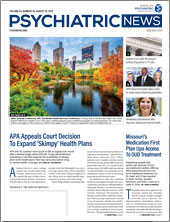APA’s Board of Trustees approved more than a dozen new or revised position statements last month, including a new statement supporting the Neuroscience-based Nomenclature (NbN) Project.
The NbN Project was organized by five international neuropsychopharmacologic groups with the goal of revising the current nomenclature for psychiatric drugs so that drug names reflect, to the extent possible, their underlying pharmacological targets and mechanisms of action. The new nomenclature would replace the arbitrary descriptors based on indication (for example, antidepressants and antipsychotics) that are used currently.
An example of this is the reclassification of the drug perphenazine. It is currently referred to as an “antipsychotic” but could be renamed a “D2 receptor antagonist.”
The five international groups involved with the NbN Project are the European College of Neuropsychopharmacology, the American College of Neuropsychopharmacology, the Collegium Internationale de Neuropsychopharmacologie, the International Union of Basic and Clinical Pharmacology, and the Asian College of Neuropsychopharmacology. Past APA President Maria A. Oquendo, M.D., Ph.D., has been a powerful proponnent of NbN and is a member of a North American working group of the NbN Project.
“Referring to drugs based on the condition that they were first discovered to address presents several problems,” Oquendo told Psychiatric News in a 2016 interview. “Most importantly, it is at odds with what happens in a clinical encounter. Many psychiatrists have likely had conversations with patients who want to know why they are being prescribed an antidepressant for anxiety or an antiepileptic for a mood disorder. It is possible that this confusion can result in problems with adherence.”
She also said that in other fields of medicine, drugs are increasingly classified according to their target receptors, enzymes, ion channels, and other biologically precise targets. Labeling medications based on an original indication divorces the treatment from the targeted biological substrates that are essential to health and recovery, she said.
“One of the best weapons we have against stigma is to reinforce the idea that psychiatric conditions are biological in nature,” Oquendo said. “A reconsideration of nomenclature would be a powerful tool in this effort.”
The position statement approved by the Board asserts, “Describing agents in terms of their pharmacologic properties, rather than approved indications, will help reduce confusion; for instance, instead of giving ‘antidepressants’ for an anxiety disorder or ‘antipsychotics’ for depression, we will talk about prescribing a ‘serotonergic reuptake inhibitor for your OCD’ or ‘recruiting another system [dopaminergic system] to fight your depression.’ ”
The statement further says that “APA encourages the inclusion of NbN terminology in scientific products, such as technical documents prepared by APA components and materials published in APA journals.” And, “APA recommends pilot trials, similar to diagnostic-manual field studies, aimed at determining whether NbN improves patient-physician communication, patient satisfaction, medication adherence, or metrics related to quality of care.”
Among other position statements that trustees approved were “Use of Opioid Medications With Terminally Ill Patients” and “Supporting Implementation of the Mental Health Parity and Addiction Equity Act.”
That latter position asserts that the Mental Health Parity and Addiction Equity Act of 2008 (MHPAEA) stipulates that all insurance plans must be nondiscriminatory with regard to financial requirements, quantitative treatment, and nonquantitative treatment limitations (see
here.). The position further asserts that federal agencies responsible for implementation and oversight of the law have issued definitive guidance as to how plans are to evaluate and document their compliance.
The statement on opioid medications for terminally ill patients replaces a 2012 statement of the same title. The 2019 statement repeats some of the 2012 language, such as the following: “The American Psychiatric Association endorses the principle that the effectiveness of relief of pain in terminally ill patients carries an extremely high priority and that fears about SUD [substance use disorder] or diversion of analgesic medications should not preclude optimum management of pain. Weighing the risks and benefits of opioid treatment of patients with severe pain requires consideration of all the potential adverse effects of the treatment, with the overriding concern being sensitive and humane treatment of the suffering patient.”
But the new statement includes five specific recommendations not included in the earlier position:
•
Terminally ill patients under consideration for opioid therapy for pain [should] receive a thorough evaluation of the pain syndrome requiring the opioid and for SUD and diversion risk as well as for co-occurring psychiatric conditions, such as depression and anxiety, that could complicate the course of treatment with opioids and which should be treated if present.
•
For patients who are identified as potentially benefiting from opioid therapy, physicians should consider co-administration of nonopioid and nonpharmacological treatments for pain with the goal of using the lowest effective dose of opioid analgesia to improve quality of life while minimizing risks.
•
The goal of treatment should be improvements in functional abilities impaired by pain and attaining an acceptable pain level rather than an absolute reduction in pain level.
•
Prescribers should continue to assess for co-occurring disorders, adverse effects of the opioid therapy, potential for diversion, and the risk of developing a new SUD.
•
Prescribers should also consider prevention of opioid overdose, including co-prescribing naloxone to patients receiving opioid pain medication and to their family members and caregivers.
In other business, trustees voted to refer an analysis of the financial impact of developing a new Council on Women’s Mental Health to the Finance and Budget Committee with a deadline to report to the Board of Trustees by its October meeting. The committee will evaluate the cost of three options: creating a new Council on Women’s Mental Health, creating a Committee on Women’s Mental Health under an existing council, or directing all councils to incorporate women’s mental health issues and to include a mechanism for ongoing tracking.
Additionally, Jacqueline Feldman, M.D., chair of the 2019-2020 IPS Work Group, gave an update on the progress of the work group, which is looking at the future of the APA’s fall meeting IPS: The Mental Health Services Conference. She reported that the group is continuing to look at a variety of options for reformatting the conference, attracting more attendees, and partnering with other groups to sponsor the conference. Additionally, she said the group hopes to survey APA members about what they like about the IPS and why they attend or do not attend. ■
APA position statements can be accessed
here. Information about the NbN Project is posted
here.

